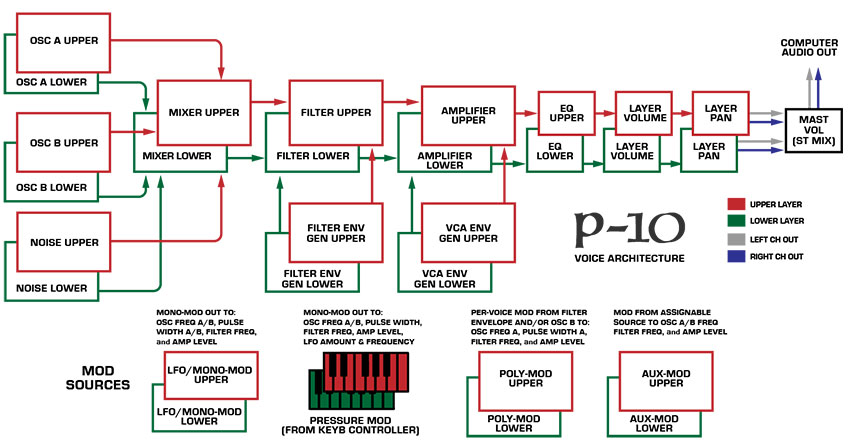
P-10's voice layout is almost identical to the original Prophet-5 synth, which itself is very similar to a Minimoog - it's a very easy to understand layout. In this section, we'll outline the basic voicing and then explain details in the following individual chapters.
The signal path begins in the center of the instrument with Oscillators A and B. The oscillators are then routed to the Mixer section for individual level control. The mixer also has a white noise source with a level control.
Following the source mixer, the signal is routed to a 24 dB/oct voltage-controlled filter (VCF), which has its own dedicated ADSR envelope generator. From the VCF, the signal travels to the voltage-controlled amplifier (VCA) for amplitude shaping via its own ADSR envelope generator.
From the VCAs, the signal is routed through a three-band equalizer and to the Layer Pan and Layer Volume controls above the EQ section. From there, the signal goes to the effects section.
Before we get to the Effects/Arpeggio page, we'll take a detour and discuss P-10's modulation capabilities. Most of the modulation functions are contained in the left side of the Program section. Here's how they work:
LFO Section- The low-frequency oscillator operates at frequencies below the human hearing range and can be routed in variable amounts to affect both oscillator frequencies, both oscillators' pulse-wave width, filter cutoff, and VCA amplitude using the controls in the Mono-Mod section.
Pressure-Mod Section- "Pressure" refers to what's commonly known as aftertouch, that is, applying modulation via further pressure after the initial key strike. Note that P-10 supports poly aftertouch (you'll need one of them newfangled MIDI/USB controllers that supports poly AT). Aftertouch can be routed to both oscillator frequencies, oscillator pulse width, filter cutoff, and VCA amplitude, LFO amount and frequency. The original Prophet-10 did not support aftertouch, but we cribbed this feature from the later Prophet T-8. (Where the "T" literally stood for "touch.")
Poly-Mod Section- This can be a little tricky to wrap your head around, but the basic idea is that it allows independent modulation of voices via either the filter envelope or Oscillator B (as opposed to a single LFO that mods everything at the same time). We'll fully explain this in the Poly-Mod user guide section.
Aux-Mod Section- This one's way over on the right side of the panel, but it's intended to function like the Pedal Mod section of the original (with the added advantage that you can use any MIDI hardware control you like, not just a pedal). It can be routed to affect both oscillator frequencies, filter cutoff, VCA amplitude, or the amount of Mono-Mod (i.e. LFO).
Now let's get back to our audio path, following the Layer Volume and Layer Pan controls. If you're following along on the instrument, now would be a good time to click the Effects/Arpeggio button in the Panel View section next to the big, garish P-10 logo.
Up to the Layer Volume control the signal is still mono; the Layer Pan knob effectively stereoizes the sound by panning it to a static position in the stereo field. In this way, the signal gets routed to the effects in stereo. Although the Distortion and Phaser effects behave as mono effects, they're actually in stereo under the hood in order to maintain the stereo positioning as defined by the Layer Pan control. The signal then gets routed serially (i.e. one-after-the-other, like your guitarist's ever-malfunctioning pedal board) through the Distortion, Phaser, Chorus/Flanger, Delay, and Reverb. Note that the Chorus/Flanger, Delay, and Reverb effects are all stereo.
Following the Reverb, the signal is routed through the Master Volume (the silver-top volume control on the main page), through the Limiter and out to TV land, er... your mixer.
P-10 Layers
Ok, pretty simple so far. Now double it...the original instrument was essentially two entire Prophet-5 five-voice synthesizers in one (real heavy) box. with dual layers that can operate in a few different modes. P-10 faithfully recreates its four modes as follows:
Normal- Operates as two single-layer polysynths with up to 16 voices each. The top manual and Upper MIDI channel play the Upper layer; the bottom manual and Lower MIDI channel play the Lower layer.
Single- Operates as a standard single-layer polysynth with up to 32 voices. Both manuals and their respective MIDI input channels play the Upper layer.
Double- The Upper and Lower layer are stacked; that is, both the Upper and Lower layer play simultaneously from either manual via the Upper or Lower MIDI channel - like "Omni" mode, for you MIDI historians.
Alternate- Layer playback alternates betwixt the Upper and Lower layers with each keystroke from either manual via the Upper or Lower MIDI channel. We're not sure why you'd want to do this, but hey, it's there, because technology.
Cherry P-10 adds an additional mode, heretofore not seen on the original instrument:
Split- The keyboard is split at a user-defined point with the Lower layer sounding below the split point, and the Upper layer sounding above the split point. Layers respond the same from either manual and the Lower or Upper MIDI channel.
Effects Routing
P-10 contains two completely independent Distortion, Phaser, Chorus/Flanger, Delay, and Reverb effects chains, allowing completely independent effects for each layer (FX Mode Dual setting). Alternatively, setting FX Mode to Global routes both layers through the same set of effects. Please see the Effects section for more information.
Sequencer
P-10's onboard four-track sequencer can easily be assigned to play the Upper, Lower, or both layers. Lots more info about this can be found in the Sequencer section.
In the following sub-chapters, we'll go over the main sound generation components of a layer.